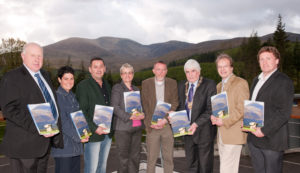Sam Moore, lecturer in Applied Archaeology at IT Sligo, recently published a book entitled The Archaeology of Slieve Donard: a cultural biography of Ulster’s highest mountain.
The book was launched by Margaret Ritchie MP at an event at the National Centre Outdoor in Tollymore Co. Down.
The project had the co-operation and support of the Northern Ireland Environment Agency, The Heritage Council, The Mourne Heritage Trust, The National Trust, Down District Council and Down County Museum. It involved an archaeological research grant from the Heritage Council and a publication grant from the Northern Ireland Environment Agency.
Sam is a prehistorian and a landscape archaeologist. Born in Dublin and now living in Co. Roscommon, he spent a considerable time living in Castlewellan, Co. Down and worked in Down County Museum. It was during this period he developed an interest and passion for the Mourne Mountains in general and Slieve Donard’s rich cultural heritage in particular.
Slieve Donard in Co. Down is the highest mountain in Ulster and the seventh highest mountain in Ireland at 849m above sea level. Sited dramatically at the eastern edge of the Mourne Mountains, with its granite summit only 3km from the northern half of Irish Sea, it provides spectacular views in all directions. Various mythical and legendary characters are associated with the summit including Boirche, a magical cowherd, Mad MacSweeney and Fionn MacCumhaill. The summit has two large circular piles of stone on it; the Great Cairn which is probably a 5000 year old Neolithic passage tomb, and the Lesser Cairn, which may be a 3500 year old Bronze Age burial site.
Both cairns have been extensively altered through time with the construction of an oratory and cell in them when they were converted by the hermit, St Donard. He was son of a local pagan chieftain and became an important disciple of St Patrick whose holy acts made him one of Ireland’s early saints. Subsequent alterations to the cairns occurred that were linked to the actions of pilgrims who would visit the summit on the last Sunday of July, the ancient Irish festival of Lughnasa, up to the 19th century. Slieve Donard became regarded as one of Ireland’s four principal Lughnasa Mountain Assemblies (the others being Croagh Patrick, Co. Mayo; Mount Brandon, Co. Kerry and Church Mountain, Co. Wicklow).
In the early nineteenth century the summit became the base for the Royal Engineers who spent several months there in 1826 during the commencement of the Ordnance Survey’s mapping of Ireland. The Great Cairn was partially dismantled during the construction of the 35km long Mourne Wall. This was built between 1904 and 1922 by the Belfast Water Commissioners to enclose the water catchment in the high Mournes. Today, large numbers of hill walkers visit the summit to enjoy the remarkable views with most not realising what an extraordinarily rich and diverse history the summit holds.
This book contains in-depth research into the story of the summit of Slieve Donard from its very origins geologically up to today. It focuses on the prehistory and pilgrimage aspects of its story and examines related sites around the region including the large amount of megalithic tombs and other sites around the mountain as well as St Donard’s monastery at Maghera and the church site St Mary’s near the Bloody Bridge. It offers interpretations of why the summit resonated with importance during the prehistoric and medieval periods, and hopes to raise an awareness of the diverse cultural wealth the Mourne Mountains and region in general contain.

Pictured from left to right above are: Desmond Patterson, Down District Council; Caro-Lynne Ferris, Heritage Council; William Clarke, Down District Council, Margaret Ritchie, MP South Down; Sam Moore IT Sligo; Dermot Curran, Chairman Down District Council; Mike King, Curator Down County Museum; Martin Carey, CEO, Mourne Heritage Trust.
